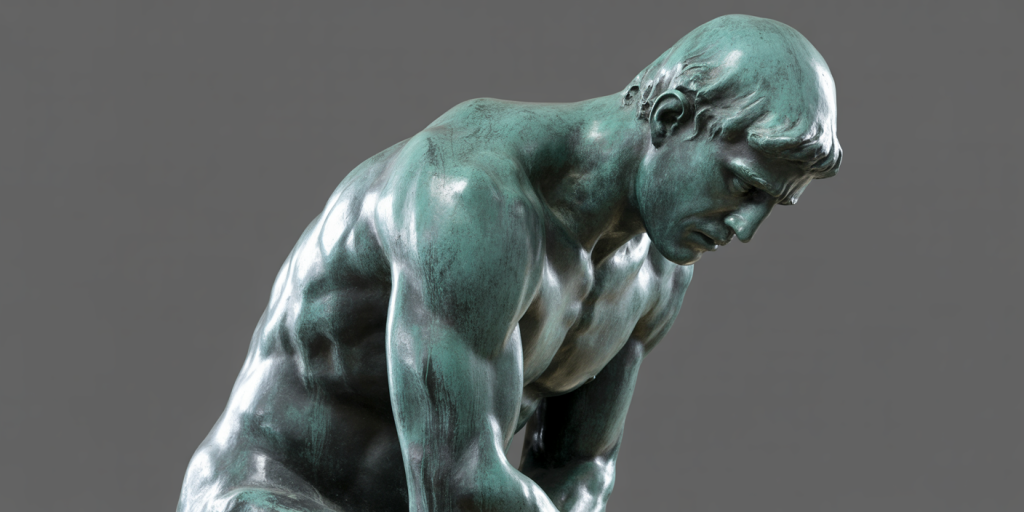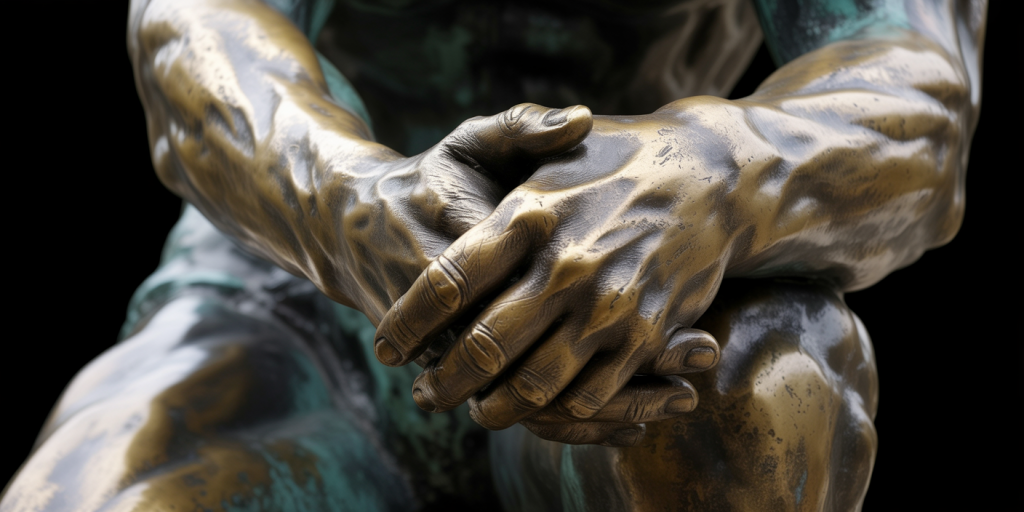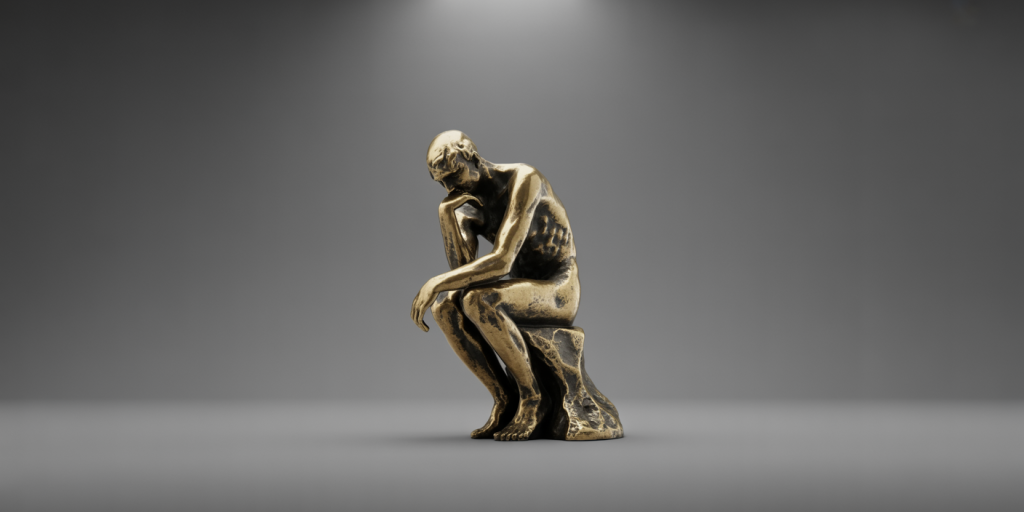Rodin Sculpts the Regret That Was Never Said
The bronze breathes. It does not speak, and yet, it murmurs beneath its mottled surface. Its silence is not empty but reverberant, like the hush that follows a confession never made. Auguste Rodin, master of flesh transfigured into stone, has shaped more than a body in this sculpture. He has conjured the moment just before a word is born—the tremble of a regret that finds no voice, suspended in the weight of eternity.
We stand before it, as if before a threshold. The figure bends not just with grief, but with the burden of something withheld. This is not merely a sculpture; it is a fossil of feeling, an ossified ache. It is not titled, yet we know its name: The Regret That Was Never Spoken.
Table of Contents
- Breath Cast in Bronze
- Muscles That Whisper Remorse
- A Back Turned to Redemption
- Shadows That Weep in Silence
- The Skin of Stone
- Gravity as Guilt
- The Pause Before the Apology
- The Spine of Sorrow
- Bronze Against Time
- The Absent Gaze
- The Weight of the Unuttered
- Anatomy of Withheld Longing
- Where the Light Refuses to Fall
- The Shape of a Shrinking Soul
- A Gesture With No Listener
- Time Wound Into Form
- Rodin and the Flesh of Feeling
- The Sculptor of Solitude
- Echoes of a Lost Word
- The Statue as a Soul’s Mirror
Breath Cast in Bronze
Rodin’s sculpture, likely derived from a study for The Gates of Hell, arrests the moment when breath is trapped within the lungs—not out of awe, but because something aches to be said. The ribcage swells like an elegy unspoken. Bronze, a material of endurance, becomes ephemeral in Rodin’s hands, catching the fleeting nature of hesitation.
The surface glistens unevenly, alive with subtle textures. Patinas vary from golden umber to storm-dark gray, like bruises of memory on skin. The form appears to pulse, as though the sculpture itself has paused in sorrow.

Muscles That Whisper Remorse
The musculature is not flexed in pride but taut with restraint. The back curves inward, an arc of vulnerability. One hand hovers, as if once extended and then withdrawn. Regret here is anatomical, nestled in every tendon.
Rodin was a craftsman of contradiction. The physical strength of the figure betrays emotional fragility. Muscles speak a language of unfinished gesture, a strength not used to lift but to hold in the unsaid.
A Back Turned to Redemption
The figure turns away—not from us, but from an invisible other, a presence we must imagine. This turning is not escape, but refusal. Perhaps shame. Perhaps the terrible realization that the moment to make amends has passed.
It is in this posture that Rodin inserts narrative. The sculpture becomes a still from an unseen story: not a climactic moment, but the void left in its absence.
Shadows That Weep in Silence
Light plays a crucial role. It does not reveal; it mourns. Cast shadows slide across the shoulders and ribcage like fingers of memory. In certain angles, the face is completely obscured, making the piece almost faceless—universal.
This choreography of shadow and shape becomes its own language. The figure is not illuminated, but veiled. Not shown, but suggested.
The Skin of Stone
Rodin often left surfaces rough, resisting classical polish. In this piece, that texture evokes the rawness of emotional abrasion. The skin of the figure is not smooth, because regret is not smooth. It is ridged, broken, peeling like old paint on a forgotten door.
Your gaze catches on these imperfections and lingers. The eye, like memory, returns to the same scar.
Gravity as Guilt
There is no pedestal high enough for this figure. It droops under its own weight, closer to earth than to Olympus. Rodin sculpts gravity as if it were guilt—an invisible force drawing the soul down into itself.
The tilt of the head, the slope of the shoulders, the bend of the knees: all angles suggest not collapse, but concession. Not defeat, but the quiet acceptance of consequence.
The Pause Before the Apology
This is not regret after the fall. This is the instant before the apology is spoken, when breath is held, words gathered—and then withheld. This suspended hesitation is more harrowing than any outburst.
Rodin captures this stillness with paradoxical motion. The body is alive, caught mid-thought. It is the sculpture of a breath held too long.
The Spine of Sorrow
The vertebrae are pronounced, like prayer beads along the curve of the back. This spine is not a column of strength, but of remembrance. Each bump is a chapter of remorse.
There is dignity in this exposure. The back is turned, yes, but not closed. The vulnerability is sacred.
Bronze Against Time
Time corrodes bronze, just as memory corrodes certainty. The green patina blooming on the surface is not decay, but testimony. Every discoloration, a confession made not to a priest, but to time itself.
Rodin embraced these transformations, knowing that bronze continues to age and evolve. Like regret, it never truly settles.
The Absent Gaze
We never see the figure’s eyes. This absence haunts. Where would that gaze fall—on the past, a lost lover, a mirror? We are denied the answer.
Instead, we see averted eyes, closed lids, a bowed head. Vision turned inward, not out. This is the anatomy of introspection.
The Weight of the Unuttered
What is unsaid carries mass. Rodin sculpts that mass. The silence clings to the figure like damp fabric. Every inch of bronze bears the sediment of suppressed words.
The lips are sealed not in stone, but in will. This is not muteness, but a chosen silence—the kind that screams within.
Anatomy of Withheld Longing
Even in stillness, the sculpture reaches. A knee stretches slightly forward, a shoulder leans. These are the echoes of motion, the ghost of an impulse.
Longing, here, is not fulfilled or even pursued. It is folded inward. The body is both cage and captive.
Where the Light Refuses to Fall
Certain crevices remain dark no matter the angle of illumination. These pockets become metaphors for emotional recesses—places even the eye dare not enter.
This darkness is not void, but density. It is the visual echo of secrets held too long.
The Shape of a Shrinking Soul
The figure seems to draw itself inward, as if trying to become less, to disappear. This is no tragic hero; this is a man who wishes to be unseen, unremembered.
Rodin does not grant him escape, but renders the desire with painful clarity. The sculpture is a contraction, a retreat, a whispered goodbye.
A Gesture With No Listener
One arm bends, hand near the chest. Is it a self-embrace, or a futile call to someone gone? The ambiguity aches.
Without a recipient, every gesture becomes a soliloquy. The hand seeks not to touch, but to remember.

Time Wound Into Form
This sculpture is not frozen time, but time incarnate. Every curve is a clock hand, every fold a calendar. Rodin does not freeze the moment; he winds it tightly until it vibrates.
To view this work is to feel time coil inside your ribs. The present tugs against the past, and the future remains unreachable.
Rodin and the Flesh of Feeling
Rodin sculpted not only bodies, but the flesh of emotion itself. His forms are never static. They breathe, bleed, yearn.
In this piece, feeling becomes corporeal. Sorrow has muscle. Regret has bone. Unspoken words find voice in the silent sinews.
The Sculptor of Solitude
Rodin knew solitude intimately. His figures often commune only with themselves. Here, the isolation is tactile. The sculpture seems to repel sound, to draw a curtain around its pain.
This is not loneliness as absence, but as fullness—a heart crowded with unsaid things.
Echoes of a Lost Word
Every surface of the sculpture seems to echo something never said. It is the fossil of a sentence. It hums, almost.
The viewer becomes part of this echo. We complete the sculpture by imagining the word it longs to speak. Each of us hears something different.

The Statue as a Soul’s Mirror
We do not merely look at the sculpture; we see ourselves reflected in it. Our own regrets stir. Our silences echo back.
Rodin’s work becomes a mirror, not of appearance, but of interiority. It is an altar where memory kneels.
FAQ
Was this sculpture part of a larger work?
Many such figures were studies for The Gates of Hell, Rodin’s monumental portal inspired by Dante. This piece likely began as one, but transcends its origins.
Why did Rodin leave parts unfinished?
Rodin believed that emotional truth lived in imperfection. Smoothness was a lie; rawness was honesty.
What material is used?
Bronze, cast using the lost-wax method. The texture is a result of both casting and post-process patination.
What style is this?
Impressionist sculpture, focusing on movement, mood, and surface. Rodin defied classical smoothness in favor of emotional realism.
Did Rodin name this piece?
This article’s title is interpretive. Rodin often left works untitled or with ambiguous names to invite contemplation.
Notes from the Threshold
Rodin’s sculpture is more than an object; it is a crossroad. We come to it not to look, but to feel. Its silence is louder than marble thunder, its stillness more poignant than motion.
To stand before it is to confront our own hesitations, our own unspoken regrets. Rodin does not give us peace, but resonance. And in that resonance, perhaps, a measure of release.
